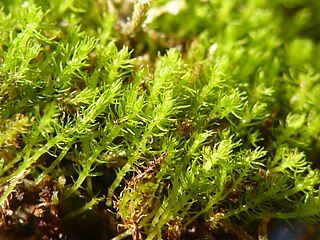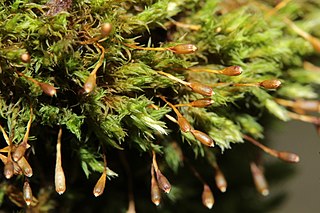
Mosses are small, non-vascular flowerless plants in the taxonomic division Bryophytasensu stricto. Bryophyta may also refer to the parent group bryophytes, which comprise liverworts, mosses, and hornworts. Mosses typically form dense green clumps or mats, often in damp or shady locations. The individual plants are usually composed of simple leaves that are generally only one cell thick, attached to a stem that may be branched or unbranched and has only a limited role in conducting water and nutrients. Although some species have conducting tissues, these are generally poorly developed and structurally different from similar tissue found in vascular plants. Mosses do not have seeds and after fertilisation develop sporophytes with unbranched stalks topped with single capsules containing spores. They are typically 0.2–10 cm (0.1–3.9 in) tall, though some species are much larger. Dawsonia, the tallest moss in the world, can grow to 50 cm (20 in) in height. There are approximately 12,000 species.

Richard Spruce was an English botanist specializing in bryology. One of the great Victorian botanical explorers, Spruce spent 15 years exploring the Amazon from the Andes to its mouth, and was one of the first Europeans to visit many of the places where he collected specimens. Spruce discovered and named a number of new plant species, and corresponded with some of the leading botanists of the nineteenth century.

Cephalotus is a genus which contains one species, Cephalotus follicularis the Albany pitcher plant, a small carnivorous pitcher plant. The pit-fall traps of the modified leaves have inspired the common names for this plant, which include 'Albany pitcher plant", "Western Australian pitcher plant", "Australian pitcher plant", or "fly-catcher plant." It is an evergreen herb that is endemic to peaty swamps in the southwestern corner of Western Australia.

Takakia is a genus of two species of mosses known from western North America and central and eastern Asia. The genus is placed as a separate family, order and class among the mosses. It has had a history of uncertain placement, but the discovery of sporophytes clearly of the moss-type firmly supports placement with the mosses.

Buxbaumia is a genus of twelve species of moss (Bryophyta). It was first named in 1742 by Albrecht von Haller and later brought into modern botanical nomenclature in 1801 by Johann Hedwig to commemorate Johann Christian Buxbaum, a German physician and botanist who discovered the moss in 1712 at the mouth of the Volga River. The moss is microscopic for most of its existence, and plants are noticeable only after they begin to produce their reproductive structures. The asymmetrical spore capsule has a distinctive shape and structure, some features of which appear to be transitional from those in primitive mosses to most modern mosses.

Plant collecting is the acquisition of plant specimens for the purposes of research, cultivation, or as a hobby. Plant specimens may be kept alive, but are more commonly dried and pressed to preserve the quality of the specimen. Plant collecting is an ancient practice with records of a Chinese botanist collecting roses over 5000 years ago.

The flora of Canada is quite diverse, due to the wide range of ecoregions and environmental conditions present in Canada. From the warm, temperate broadleaf forests of southern Ontario to the frigid Arctic plains of Northern Canada, from the wet temperate rainforests of the west coast to the arid deserts, badlands and tundra plains, the biodiversity of Canada's plants is extensive. According to environment Canada the nation of Canada hosts approximately 17,000 identified species of trees, flowers, herbs, ferns, mosses and other flora. About 4,100 species of vascular plants are native to Canada, and about 1,200 additional non-native species are recorded as established outside cultivation there.

John Macoun was an Irish-born Canadian naturalist.
Marlothiella gummifera is a species of flowering plant in the family Apiaceae, and the only species in the monotypic genus Marlothiella. It is endemic to Namibia, where its natural habitats are rocky areas and cold desert. It is also the only genus in the tribe Marlothielleae, of the subfamily Apioideae.

Ambuchanania leucobryoides is the only species in the monotypic genus Ambuchanania. It is a Sphagnum-like moss endemic to Tasmania. Originally described as a species of Sphagnum, it is now a separate genus named after the original collector Alex M. Buchanan, (b.1944) an Australian botanist from the Tasmanian Herbarium in Hobart,. A. leucobryoides differs from the family Sphagnaceae in having elongate antheridia. It is entirely restricted to south-west Tasmania's Wilderness World Heritage Area where it occurs on white Precambrian quartzitic sand deposited by alluvial flows, and on margins of buttongrass sedge land. Species most commonly found in association with A. leucobryoides include: Leptocarpus tenax, Chordifex hookeri, and Actinotus suffocatus. Currently, A. leucobryoides is listed as rare under the Tasmanian Threatened Species Protection Act 1995.

Diphyscium is a genus of mosses in the family Diphysciaceae. Members of this genus are small, perennial plants. The capsule does not elongate much, and remains buried among surrounding leaves.
Flabellidium is an extinct genus of moss in the family Brachytheciaceae. It contains a single species, Flabellidium spinosum, also known as the Santa Cruz bryophyte.
Hattoria yakushimensis is the only species of liverwort in the genus Hattoria, in the family Anastrophyllaceae. It is endemic to Japan. Its natural habitat is temperate forests. It is threatened by habitat loss.
Calymperastrum latifolium is the sole species in the monotypic moss genus Calymperastrum. It is a poorly known moss, having been collected only three times. All three collections were from the trunks of Macrozamia, in the Southwest Botanic Province of Western Australia. It is presumed endemic to the region, making it the only moss genus known endemic to that state.
Distichophyllum carinatum is a species of moss in the family Daltoniaceae. It is native to Europe and Asia, where it has a disjunct distribution. It is known to occur in Germany, China, and Japan. It is also known from Austria and Switzerland, but it may be extinct there today. It is very uncommon where it still occurs, growing in only four locations. It is listed as an endangered species by the International Union for Conservation of Nature.

Ulota is a genus of mosses comprising 69 species with a worldwide distribution, though most species are found in the southern hemisphere.
Drummondia is a genus of haplolepideous mosses (Dicranidae) in the monotypic family Drummondiaceae.
Bryolawtonia is a monotypic genus of mosses belonging to the family Neckeraceae. It only contains one known species, Bryolawtonia vancouveriensisNorris & Enroth, 1990

Polytrichum piliferum, the bristly haircap, is an evergreen perennial species of moss in the family Polytrichaceae. The bristly haircap moss is small-sized to medium-sized and forms loose tufts with wine-reddish stems. It is an acrocarpous moss that appears bluish-green to grey. This moss grows in clumps on erect shoots and becomes a red-brown colour as it grows older. The most distinguishing feature of P. piliferum is the long, white awn at the tips of the leaves, which also give this moss its grey colour. It is the only species in its genus where the awn is completely hyaline.











